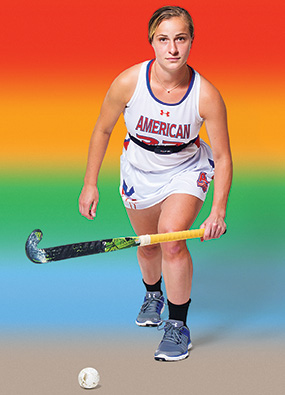
Less than a minute remained in the AU field hockey team's Patriot League opener against Bucknell when midfielder Sammie McCormick stuffed in a rebound for the game's first goal. Strapped to her chest under her blue uniform that day in mid-September was a tool that's played a vital role in the senior's steady improvement throughout her career.
Actually, McCormick (pictured) and her teammates wear a heart rate monitor during every game, practice, and workout. It's part of what coach Steve Jennings calls "biomeasurement," and he and his players believe the data it collects have made them better athletes—and the Eagles a stronger team.
"[It's] helped my fitness, which has improved over the years," McCormick says. "They have also helped with my overall speed on the field. [I'm] faster when dribbling the ball, faster getting open, and faster [to recover] on defense."
Jennings began outfitting his players with the devices, which are about the size of a car-key fob, three years ago. They record players' heart rates, which he and his assistant coaches download to a computer. An algorithm then computes each player's training load—essentially the intensity of their workout. Based on those numbers, Jennings can increase or decrease the intensity of drills and practice overall. The idea is to have each player operate at 90 percent of her capacity during practice, and in a broader sense, to have the team in peak physical shape during the postseason.
The system separates each athlete's training load into four zones to quantify how hard her heart worked during physical activity.
"What we are looking to do is get you in certain zones when we train and play," Jennings says. "The red zone is 90 percent to 100 percent of your individual max. We try to organize our training so that we are in the red, and then when we stop, the athletes go back down into the lowest category possible for their recovery."
Prior to implementing biomeasurement, Jennings says the team would train to the mean. When running a set of 400-meter sprints, for example, each player rested for the same period of time between laps. What the heart rate data have shown is that the faster athletes at the front of the pack actually needed less rest than they were getting, while those in the back needed more.
Now coaches have players start their next lap when their heart rate hits a level that's been calculated as ideal for each individual's needs.
"Of course everyone has their own variables—it's impossible to know everything about them—but I think in general it's helped us tremendously," Jennings says. "Last year we were able to have our athletes peaking physiologically at the Patriot League Tournament, the most critical weekend of the year for us."
In the second half of that game against Bucknell earlier this year, AU exploded for three goals on its way to an easy 4–1 win. In every way that counts, the team showed great heart.